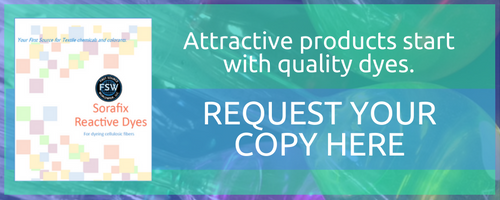The Improvements of Exhaust Dyeing Blacks on Cotton
The Advances in Dyeing Economical Deep Black Shades on Cotton and Cotton Blends with Good Fastness in Exhaust Dyeing
The industry uses mainly reactive dyes for exhaust dyeing black shades to cotton. But, prior to the introduction of Reactive Black 5 in the 1950s, black shades on cotton and cotton blends were predominately dyed with either Direct or Sulphur dyes. At first, Reactive Black 5 was three to five times more expensive. It required lower liquor due to the hydrolyzation of the dye and needed more process controls, things the equipment they had could not provide. Due to these barriers of entry, reactive dyes didn’t catch on for a number of years.
Development Begins to Improve Reactive Dye Process
Changes began to occur the early 1970s. With the introduction of jet dyeing and package dyeing equipment, the reactive dye barriers began to diminish. The new equipment allowed for lower liquor ratios and more programmable process controllers.
Yet, even with the new equipment, the cost per pound was still higher than other alternatives. But, repeatability of shades increased with better wet fastness properties. This helped encourage the investment in using the dyes, as they had better long-term success.
Two factors led to the cost problems with reactive dyes:
- Cost per pound of the reactive dyes used for matching black shades.
- The percentage of dye required to match deep shades.
Typical formulas contained 9 – 12% dye similar to the following:
Reactive Black 100%: 6 – 7%
Reactive Orange 16 100%: 2.5 – 3.5%
Reactive Red 180: 1 – 2%
Improvements Drive the Industry for Overall Reactive Dye Use
By the late 1970s, new advancements emerged in lower liquor ratio dyeing equipment and process controls. Other factors included the growth of suppliers offering lower cost reactive dyes. This low cost model manifested after many patents expired on the dye classes and new technology aided in developing new, stronger reactive dyes. These factors allowed for reactive dyes to grow to become the most widely used dyes for black shades on cotton.
But, the market wanted even deeper black shades.
Due to relative low percentage of fixation (55 – 56%), the cost of reactive dyes used was still too high. In addition, this period saw many increases in water and energy costs.
Typical formulas still contained 8-11% dye similar to the following:
Reactive Black 5 133%: 5 – 6%
Reactive Orange 72 & 78 150%: 2 – 3.5%
Reactive Red 195 & 198: 0.5 – 1.5%
Reactive Black 5 is actually a navy, not a black. Because of this, formulations required 35 – 40% of a shading component to make deep black shades. In the mid-1980s, dye manufacturers introduced new reactive blacks, such as Black FB and Black N. Since these were still based on Reactive Black 5, they still could not produce the desired deep black, even with improved shading components of 20 – 30%.
Beginning in the early 1990s a third generation of reactive blacks emerged, one of which was Black FB3DP. Although the products were still based on Reactive Black 5, they started double coupling with Reactive Orange and produced a stronger and deeper black tone. Typical formulas could now be produced with 7 – 8% total dye and contained 10 – 20% shading components.
But as expected, the market continued to want deeper black shades with good wet fastness properties and lower costs.
Final Development Set the Industry Standard for Deep Blacks on Cotton
Suppliers began to offer a fourth generation of reactive black. Again, they are still based on Reactive Black 5, but they’re coupled with new components to obtain Deep-Jet Black shades. They produce higher fixation, lower costs, and meet wet fastness requirements. Along with the fourth generation of products was the introduction of new shading components. These also have higher fixation, lower costs, and meet wet fastness requirements.
Today a typical formula to make Deep-Jet Blacks is similar to the following:
Sorafix Supra Black GN (Greener Shades): 3.5 – 5.5% or Sorafix Supra Black RN (Redder Shades): 3.5 – 5.5%
Sorafix Orange SS: 0.2 – 5.5%
Sorafix Red MF-3BD: 0.2 – 0.4%
After generations of development, we’re finally able meet market demands. With Deep-Jet Blacks, their economical formulations meet wet fastness requirements and need less water and energy in operations. This makes them more production-friendly while increasing performance on cotton fabrics.
Are you using reactive black dyes that aren’t giving you the depth in shade you need? Click the button below to request technical support and an introduction to our Sorafix Supra Black products.



